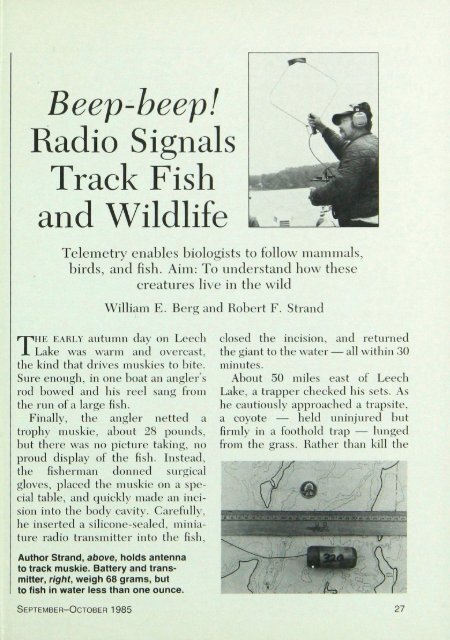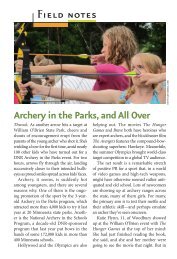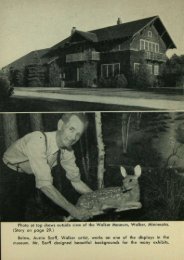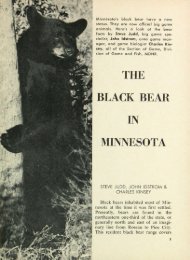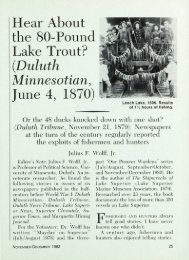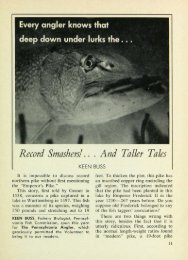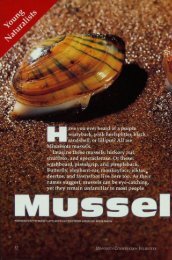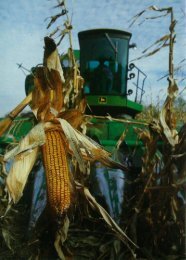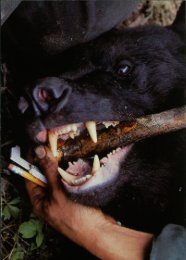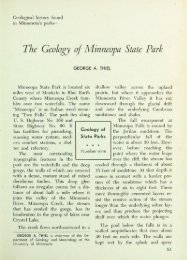215 Beep-beep! Radio Signals Track Fish and Wildlife - webapps8
215 Beep-beep! Radio Signals Track Fish and Wildlife - webapps8
215 Beep-beep! Radio Signals Track Fish and Wildlife - webapps8
You also want an ePaper? Increase the reach of your titles
YUMPU automatically turns print PDFs into web optimized ePapers that Google loves.
<strong>Beep</strong>-<strong>beep</strong>!<strong>Radio</strong> <strong>Signals</strong><strong>Track</strong> <strong>Fish</strong><strong>and</strong> <strong>Wildlife</strong>Telemetry enables biologists to follow mammals,birds, <strong>and</strong> fish. Aim: To underst<strong>and</strong> how thesecreatures live in the wildWilliam E. Berg <strong>and</strong> Robert F. Str<strong>and</strong>HETEARLY autumn day on LeechLake was warm <strong>and</strong> overcast,the kind that drives muskies to bite.Sure enough, in one boat an angler'srod bowed <strong>and</strong> his reel sang fromthe run of a large fish.Finally, the angler netted atrophy muskie, about 28 pounds,but there was no picture taking, noproud display of the fish. Instead,the fisherman donned surgicalgloves, placed the muskie on a specialtable, <strong>and</strong> quickly made an incisioninto the body cavity. Carefully,he inserted a silicone-sealed, miniatureradio transmitter into the fish,closed the incision, <strong>and</strong> returnedthe giant to the water — all within 30minutes.About 50 miles east of LeechLake, a trapper checked his sets. Ashe cautiously approached a trapsite,a coyote — held uninjured butfirmly in a foothold trap — lungedfrom the grass. Rather than kill theAuthor Str<strong>and</strong>, above, holds antennato track muskie. Battery <strong>and</strong> transmitter,right, weigh 68 grams, butto fish in water less than one ounce.SEPTEMBER-OCTOBER 1985 27
<strong>Radio</strong>-tracking <strong>Wildlife</strong>coyote for its pelt, the trapper removeda sterile syringe from hispack, filled it with tranquilizer, <strong>and</strong>drugged the coyote. Then heclipped a number tag onto each ear<strong>and</strong> placed a radio collar around thecoyote's neck. After recovering fromthe drug, the coyote scamperedaway.A strange way to fish <strong>and</strong> trap?Not really. The fisherman <strong>and</strong> trapperwere both Department of NaturalResources biologists learningmore about Minnesota's fish <strong>and</strong>wildlife through a technique calledradio-telemetry.Miniature Transmitter. <strong>Radio</strong>telemetryhas been used worldwideby fish <strong>and</strong> wildlife researchers fornearly 30 years.The technique is rather simple. Aradio transmitter is placed on or inthe animal. Each transmitter is aminiature radio station, with its ownbattery, antenna, <strong>and</strong> frequency.The <strong>beep</strong>-<strong>beep</strong> from the transmittercannot be heard by the animal, butonly by a biologist using a specialreceiver <strong>and</strong> antenna.<strong>Wildlife</strong> telemetry has made dramatictechnological advances sincethe 1950s, due mainly to solid-stateelectronics <strong>and</strong> the development ofmercury, nickel-cadmium, <strong>and</strong> nowlithium batteries.Transmitters must not inhibit theanimal's normal habits <strong>and</strong> canweigh no more than 2-5 percent ofthe animal's weight, or I-IV4 percentof a fish's weight. The smallest 1transmitters are jelly-bean-size, butmost are larger. Battery-poweredtransmitters operate for one to fiveyears, <strong>and</strong> those using solar powercan operate almost indefinitely.To aid biologists in their studies,dozens of animals <strong>and</strong> fish in recentyears have been equipped withtransmitters. Examples of mammals:moose, deer, wolf, bear,coyote, red fox, bobcat, Canadalynx, pine marten, cottontail rabbit,beaver, <strong>and</strong> pocket gopher.Birds include ruffed, sharptailed,<strong>and</strong> spruce grouse, great grayowl, eagle, s<strong>and</strong>hill crane, wild turkey,<strong>and</strong> several species of ducks<strong>and</strong> geese. <strong>Radio</strong>ed fish includemuskie, trout in Lake Superior,sunfish, perch, walleye, <strong>and</strong> paddlefish.Most transmitters are placed on28 Collar with transmitter, above, will allow fawn's neck to grow. Largeanimals, like bear <strong>and</strong> moose, right, are tranquilized before transmitteris attached. Bright collar aids in sighting animal in dense woods.
<strong>Radio</strong>-tracking <strong>Wildlife</strong>Battery-powered radioreceivers track animalsin field. Farleft: Biologist holdsportable antenna ashe homes in on subject.Left: Antenna ismounted on roof oftruck. Compass cardprovides directionof subject.mammals as neck collars. However,they may be clipped to an ear of adeer or moose, or sewn into thecheek of a pocket gopher. Thetransmitter is surgically implantedinto the body cavity of fish <strong>and</strong>aquatic mammals like mink <strong>and</strong>otter.Birds usually carry transmitterson their backs, held with a harnessof surgical tubing. On a turtle, thetransmitter is epoxied to the shell.Telemetry Studies. Telemetry -—transmitting audio or visual radiosignals over a distance — is the biologist'sonly method for locating ananimal without seeing or otherwisedisturbing it. Telemetry has enabledDNR fish <strong>and</strong> wildlife biologists tostudy their subjects in many ways:• In northwestern Minnesota, themoose's dependence on willow habitatwas substantiated• Behavior, movements, <strong>and</strong> dispersalpatterns of timber wolves,coyotes, bear, <strong>and</strong> deer over muchof northern Minnesota have beendocumented• <strong>Radio</strong>-collared whitetail fawnsin southeastern Minnesota led biologiststo favored doe-fawn habitats• Telemetry of wild turkeys in thesoutheast indicated causes of mortality<strong>and</strong> led to our first turkeyhunting season• Preferred nesting <strong>and</strong> broodrearinghabitat were identified forseveral species of waterfowl• Transmitters on the rare greatgray owl located existing habitats<strong>and</strong> demonstrated the bird's abilityto fly great distances into Manitoba<strong>and</strong> Ontario in search of prey• Implants in Lake Superior troutpermitted following their movementsin the big lake• Implanted transmitters in muskiespinpointed spawning groundsin Leech Lake <strong>and</strong> spawning time.This led to a delay in our muskieseason until the first Saturday inJune, <strong>and</strong> enabled the DNR to obtainspawn to propagate the Leech30 THE MINNESOTA VOLUNTEER
Lake (Mississippi) strain muskie.Telemetry Versatility. In radiotelemetry,tracking is most oftendone from a vehicle, aircraft, boat,or tower to determine an animal'slocation. But telemetry's other applicationsare limited only by thebiologist's imagination. Examples:• Activity sensors in transmittersreveal if an animal is dead or alive,feeding, or resting• Physiologic transmitter implantsbroadcast an animal s bodytemperature, heartbeat, <strong>and</strong> bloodpressure• Temperature-sensitive thermistortransmitters inside a dummyduck egg reveal the temperature ofincubation, when a hen is present,<strong>and</strong> when the egg is turned. Thermistorsalso indicate the water temperaturesought by fish, a coldbloodedanimal• <strong>Fish</strong>eries managers place transmittersin test nets far out in Lake ofthe Woods to locate nets quickly• Conservation Officers implanttransmitters in illegally taken fish<strong>and</strong> wildlife to apprehend game-lawviolators.Technological innovations arefurther advancing telemetry. Satellitesreceive some transmitter signals<strong>and</strong> relay them to an earthboundbiologist, or to an automaticrecorder, which then transfers theinformation to computer tape. Atransmitter equipped with a tranquilizerdart can drug a radioequippedanimal at the push of abutton when the animal needs a newtransmitter. A tiny transmitter in atranquilizer dart leads researchersto drugged animals which otherwisecouldn't be found.<strong>Wildlife</strong> telemetry techniqueshave spread to other fields. Wideranginghunting dogs may carry atransmitter collar so their masterscan locate them. Habitual w<strong>and</strong>erersfrom nursing homes mayhave a transmitter sewn into theircoats so they can be located if lost.And law enforcement officers nowuse telemetry to apprehend pursesnatchers, heavy equipmentthieves, <strong>and</strong> drug smugglers.As transmitters become smaller<strong>and</strong> more sophisticated, there's essentiallyno limit to fish <strong>and</strong> wildlifetelemetry applications in the studyof our fish <strong>and</strong> wildlife. •William E. Berg is a research biologistwith the DNR Forest <strong>Wildlife</strong>Populations <strong>and</strong> Research Group.Gr<strong>and</strong> Rapids. He wrote "MountainLions in MinnesotaP in the May—June 1984 Volunteer. Robert F.Str<strong>and</strong> is a fisheries biologist. DNR.Bemidji.Who Owns the L<strong>and</strong>P"THE LAND belongs to the future. . . . We come <strong>and</strong> go, hut the l<strong>and</strong> is alwayshere. And the people who love it <strong>and</strong> underst<strong>and</strong> it are the people whoown it — for a little while. — Willa Gather. () PioneersSEPTEMBER-OCTOBER 1985 31


